Paul Revere and the
Raiders

Top (L-R) Drake Levin, Mark Lindsay, Phil Volk
Bottom (L-R) Paul Revere, Mike Smith
Paul Revere and the Raiders emerged from the rock and roll
scene of the Northwest to become a national pop success, trading
on the enormous teenybopper appeal of ponytailed lead singer Mark
Lindsay
Members:
Paul Revere - keyboard
Mark Lindsay - saxophone and lead singer
Drake Levin - lead guitar -replaced by Jim
Valley - replaced by Freddy Weller
Phil Volk - rhythm guitar - replaced by
Charlie Coe - replaced by Keith Allison
Mike Smith - drums - replaced temporarily by
Joe Correro Jr.
Paul Revere was born January 7, 1938 in Harvard,
Nebraska, and grew up in Boise, Idaho. As with any unusual name,
it subjected the young Revere to some schoolyard ribbing, such
that even after he started in the entertainment business, he
never thought of using it professionally.
Early on Revere did think of entertainment. When
he was small he would go to the movies and see the Hoosier
Hotshots and Spike Jones and the City Slickers. It was then that
he first thought of mixing music and comedy together.
The music that Revere listened to as he grew up
was boogie-woogie, and like many people of his age, the success
of the early rockers of the mid-'50s was the inspiration to play
the music himself. To the piano-playing Revere the main catalyst
was Jerry Lee Lewis, whose "A Whole Lotta' Shakin' Going
On" became a smash hit when he was 19.
Revere after high school went to barber college,
opened his own barber shop, and eventually opened a drive-in
restaurant, the Reed 'n' Bell, in Caldwell, Idaho. Possessing
considerable business insight, Revere approached rock and roll
with a far more professional attitude than his peers, and soon
after joining a local band, began to transform them into a polish
act.
At that time Mark Lindsay, a 16 year old who had
already sung in a high school band, was working in a bakery
across from Revere's restaurant. Revere's band had caught
Lindsay's ear and it was while they were playing at a local dance
at the Elks Hall and walked on stage and asked to sing a song
with them.
The next day Revere walked into the bakery to
pick-up a delivery and told the bespectacled bun boy with flour
on his face and baker's hat on his head, about the crazy, skinny
kid who had gotten up onstage the night before.
"How was he?" Lindsay asked. Revere replied
"He wasn't bad." Lindsay whipped of his hat and glasses
and said "It was me!" Lindsay
Soon Lindsay had replaced the band's lead singer
and, picking up the tenor saxophone, became a full paid member of
the group, which eventually became called Downbeats, a name taken
from the jazz magazine. At the end of the '50s, the Downbeats
were playing sock hops and after game dances at high school, but
aspired to more. That is what led Revere and Lindsay to a small
recording studio in the area, where they cut a half dozen tracks.
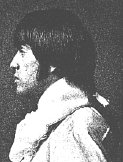
Mark Lindsay
Revere took the tapes to Los Angeles and began
knocking on doors without much success until he stopped at the
Gardenia pressing plant of John Guss. Not only did Guss agree to
cut a record from Revere's tape, but when he found out Revere's
name suggested a name change to Paul Revere and the Nightriders.
Revere rejected the name, but later settled on Paul Revere and
the Raiders, which was the name that appeared on the groups first
single, a boogie woogie version of Chopsticks called
"Beatnik Sticks."
Revere then went around to radio stations in
Idaho plugging the song as well as it's follow-up, "Paul
Revere's Ride," but it was the group's third single
"Like Long Hair," an instrumental which crossed the
serious classical style of Rachmaninoff with Jerry Lee Lewis,
that caught on nationally.
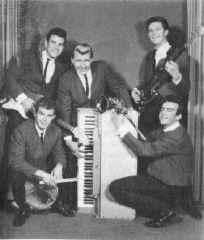
Paul Revere and the Raiders 1964
Top L-R: Phil Volk, Paul Revere, Drake Levin
Bottom L-R: Mike Smith, Mark Lindsay
Photo Courtesy Jeff Miller
"Like Long Hair" entered the charts in
March 1961, eventually reaching the Top 40 and even got on
American Bandstand. Revere was unable to follow up the records
success since, by the time the it peaked in the charts, he had
been drafted. In fact, a two week national tour without him, as
Lindsay fronted a band called "Paul Revere's Raiders that
included a young Leon Russell subbing for him on the piano.
Revere's was assigned Conscientious Objector
status due to his family's Mennonite religion, and he chose to
serve his alternative service as a cook at a mental institution
in Wilsonville, Oregon. Lindsay moved to California, but returned
in 1962 to join Revere in a new version of the band.
The two joined with Roger Hart, a disc Jockey
from KISN in Portland, to promote shows at local teen dances and
armories, and he became their manager.
A variety of bassists and guitarists passed
through the Raiders during 1962 and 1963, while Portland
born drummer Mike Smith turned out to be a long term group
member.
The band began honing its style at local dances,
adding hard driving R&B from the black charts to their
repertoire and developed a manic showmanship that would become
their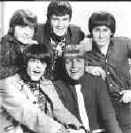 onstage
trademark. The front line Lindsay, the bassist, and the guitarist
would perform choreographed steps, while Revere performed his own
crazy antics in back and often climaxed the show by setting his
$50 upright piano on fire.
onstage
trademark. The front line Lindsay, the bassist, and the guitarist
would perform choreographed steps, while Revere performed his own
crazy antics in back and often climaxed the show by setting his
$50 upright piano on fire.
With such tactics, and Hart's promotional help,
the Raiders became a big regional act, rivaling the success of
the Seattle based Wailers. One of the Raider's most popular songs
was "Louie, Louie." The Raiders continued to record at
Gardena, but despite their early success with "Like Long
Hair" making records wasn't Revere's primary goal. The
Raiders were to be a working rock and roll touring band.
Roger Hart suggested that the group record
"Louie, Louie." The master recording cost $40 to
cut at Northwest Recorders in Portland, where it was made at
roughly the same time that the Kingsmen, another local group,
recorded the same song at the same studio. The Raiders version
came out first April 25, 1963), but the Kingsmen's' (early May
1963) went on to become a monstrous hit.
However, Ken Bolster the local Columbia Records
rep, requested a copy of the Raiders and within a few weeks they
received a phone call from David Kapralick of CBS and signed with
Columbia.
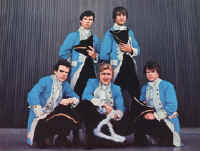
photo courtesy The Phil "Fang" Volk Fan Page
It was at this time that Revere and Lindsay
discovered the Raiders' look in a dusty old costume shop in
Portland Oregon. While walking down Southeast Broadway in
Portland, they passed a costume shop and discovered some George
Washington type uniforms.. Laughing and saying "that's
the way the old guys used to dress," they rented the
costumes.

That night during the second half of their show
at Lake Oswego Armory, the Raiders went on wearing their
costumes.The whole attitude changed. It was suddenly the Marx
Brothers on stage. Nobody had seen anything like it. Seeing how
much fun it was for both the Raiders and the audience Revere
began thinking knew he had discovered something. Soon Revere was
having Revolutionary War costumes, complete with tri-corned hats,
custom made.
With steady work and the Columbia signing, the
Raiders solidified as a quintet featuring Revere, Lindsay, and
Smith, guitarist Drake Levin and bassist Mike "Doc"
Holiday, both formerly of the Sir Winston Trio (also known as the
Surfers), who joined the band at the end of summer of 1963.
The Raiders' follow up to "Louie,
Louie" was "Louie - Go Home, " only enjoyed
regional success as did their third Columbia single "Over
You."
Columbia now assigned staff producer Terry
Melcher to handle the Raiders' recordings. Melcher was a
recording star in his own right with his partner Bruce Johnston,
turning out surf hits under the names of the Ripchords and Bruce
and Terry.
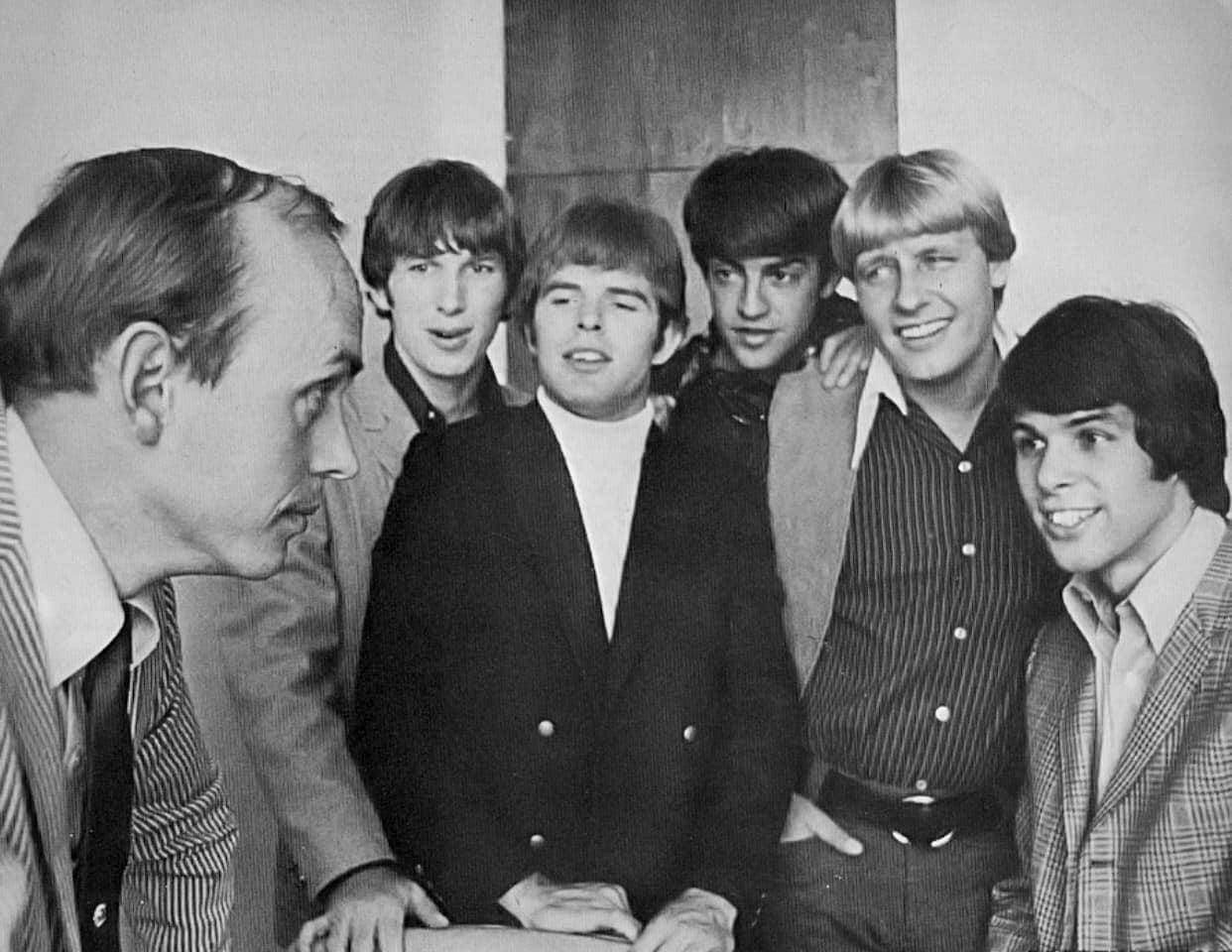
Roger Hart and the Raiders
The Raiders continued to play in their
strongholds in the Northwest and Hawaii during 1964 to 1965,
weathering the British invasion.
Just as Revere credits Hart as the inspiration to
record "Louie, Louie," it was Hart that contacted Dick
Clark when Clark was looking for a backup group to use on his
upcoming pilot for a show to be called Where the Action Is.

(Front L-R) Paul Revere, Dick Clark, Mike Smith
((Back L-R) Drake Levin, Paul Volk, Mark Lindsay
For the Raiders, the summer of 1965 was what any
popular artist dreams of. Where the Action Is premiered on ABC-TV
on June 27. In July, the Raiders played at a CBS records
convention in Miami that lead to company approval for a
nationwide summer tour. The combination of TV exposure and live
experiences pushed their debut album in the charts.
When the Raiders were hired for Action, they were
just one of a cast of members that included Linda Scott, Steve
Alaimo, Tommy Roe among others. However, the group was so visual
and with their craziness they over shadowed all the others.

Steve Alaimo, Mike Smith, Mark Lindsay, Phil Volk,
Linda Scott, Paul Revere, and Drake Levin
At the end of 13 weeks, with their first Top 50
hit, "Steppin' Out" moving up the charts, the Raiders
were able to renegotiate their contract becoming the shows stars.
In October , the Raiders followed up
"Steppin Out" with what was to become one of their all
time classics "Just Like Me." Written by Rick
Dey, a big Raider fan from the Northwest, "Just Like
Me" was released in November 1965. With a sizzling
multi-tracked guitar solo by Levin, it became the groups' first
Top 20 hit.
The Raiders' next song "Kicks," an
anti-drug song written by Barry Mann and Cynthia Weil, went into
the top five. Then came another Mann-Weil composition
"Hungry" and another smash hit. But, at this time the
group was starting to developing its own songwriting and Melcher
began using session musicians on the Raiders' recordings

Jim Valley, Mark Lindsay, Paul Revere, Phil Volk, Mike Smith
The first product of these two developments was
"The Great Airplane Strike," a Lindsay-Melcher
composition that became a Top 20 hit in 1967. By this time the
Raiders' personnel had changed as Levin had been drafted and went
into the National Guard. Though, Levin still found time to
work in the studio, Jim Valley, a veteran of such Northwest bands
as Viceroys and Don and the Goodtimes, came in to replace him,
primarily on Action and tour.
Hits continued to come with "Good
Thing," reaching to Top 5 in early 1967, followed by
"Ups and Downs," a more modest success two months
later. By this time Actions' two year TV run was coming to an end
and Volk, Smith and Levin, (who had returned replacing Valley)
decided to leave the group and go off on their own.
Revere searched for replacements, first adding
Atlanta based guitarist Freddy Weller, who joined the group for
its first live appearance on a late April Ed Sullivan Show to promote the next single "Him or Me - What's It Gonna
Be," another Top 5 hit. After the show, Revere brought back
Charlie Coe and hired drummer Joe Correro Jr, to complete the
group.
promote the next single "Him or Me - What's It Gonna
Be," another Top 5 hit. After the show, Revere brought back
Charlie Coe and hired drummer Joe Correro Jr, to complete the
group.
In the studio, the change only extended Lindsay
and Melcher's use of session musicians and overdubbing. This
experimentation reached its apex with the next single, "I
Had a Dream," a Top 20 hit released in July.
At this time the Beatles records such as
"Penny Lane"/"Strawberry Fields Forever"
single and Sgt. Pepper album radically the demands of their pop
music peers. These musical developments were paralleled by the
rising social consciousness of the time, which led to the lyrical
sentiments as the one expressed in the Raider's next single
"Peace of Mind" and the title of their next album
Revolution!. They also recorded a seasonal album, A Christmas
Present..and Past. This proved to be Melcher's swan song, as
Lindsay took over the writing and producing. Lindsay produced his
first Raider single in December 1967, "Too Much Talk"
that returned to more uptempo style of earlier hits and nearly
reached the Top 10 in early 1968.
The success of "Too Much Talk" was
assisted by a new Saturday morning TV show, Happening '68, hosted
by Revere and Lindsay, that premiered in January.
Meanwhile, Lindsay continued to write and produce
the Raiders' records. In the summer Keith Allison replaced Coe on
the bass, the Raider lineup of Weller, Correro, and Allison
presented Lindsay with a seasoned band who were often used in the
studio.
The next single release in May was "Don't
Take It So Hard."
During this period changes were in the air as era
saw the rise of rock criticism in the forms of such magazines
Crawdaddy and Rolling Stone. Lindsay now encountered the problem
of having to write songs that weren't to heavy for the Raiders'
fans, but not so light that they wouldn't be taken serious by the
media.
Despite continuing success of the singles, the
Raiders' started receiving less airplay based on who they were.
An example was "We Gotta All Get Together," reached #25
on the sales based Cash Box magazine chart, but only got to #50
in Billboard, which factored airplay into its chart.
In an attempt to shed their image they changed
the name of the group to simply the Raiders. The result was
confusion, which probably hurt the sales of the first
"Raiders" single, an uptempo rocker called "Just
Seventeen," and couldn't have helped the performance of Collage,
the album Lindsay was pinning his hopes on. The album was only to
reach #154 on the Billboard chart.
However, the Raiders' biggest hit was yet to
come. Columbia A&R man Jack Gold, noting the success of Don
Fardon's recording of John Loudermilk's song "Indian
Reservation (The Lament Of The Cherokee Reservation Indian)"
on the British Charts in the fall of 1970 suggested that the
Raiders record it. The Raiders cut the song "Indian
Reservation (The Lament of the Cherokee Reservation Indian)"
in November 1970. Indian Reservation" became the Raiders
only #1 song.
By this time, the band's concert appearances had
changed, revealing contrasting attitudes between Revere and
Lindsay. Revere wanted to play small venues, lounges, and clubs
which provided the opportunity to make the group into a tighter
and more entertaining stage act. For Lindsay this was the last
straw, and he left the Raiders at the start of 1975.
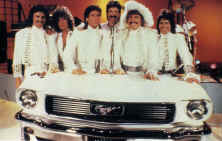
Raiders Members 2005
Paul Revere, Jamie Revere, Carl Driggs, Omar Martinez, Doug
Heath, Daniel Krause, and Ron Foos.
In 1988, Paul Revere and Righteous Brother Bill
Medley opened the oldies dance club Kicks in Reno, Nevada.
In October 2014, the band's web site announced
that Revere had died "peacefully" on October 4, 2014,
at his Garden Valley, Idaho home, a "small estate
overlooking a tranquil river canyon", from cancer. He was 76
years old.
Drake Levin died of cancer July 4, 2009 at his
home in San Francisco, he was 63.
Mike Smith died of natural causes March 6, 2001 in Kona, Hawaii,
he was 58.
Paul Revere died October, 14, 2014 in Garden Valley, Idaho, he
was 76.
Keith Alllison died at his home in Sherman Oaks,
California on November 17, 2021, at the age of 79.




 onstage
trademark. The front line Lindsay, the bassist, and the guitarist
would perform choreographed steps, while Revere performed his own
crazy antics in back and often climaxed the show by setting his
$50 upright piano on fire.
onstage
trademark. The front line Lindsay, the bassist, and the guitarist
would perform choreographed steps, while Revere performed his own
crazy antics in back and often climaxed the show by setting his
$50 upright piano on fire.





 promote the next single "Him or Me - What's It Gonna
Be," another Top 5 hit. After the show, Revere brought back
Charlie Coe and hired drummer Joe Correro Jr, to complete the
group.
promote the next single "Him or Me - What's It Gonna
Be," another Top 5 hit. After the show, Revere brought back
Charlie Coe and hired drummer Joe Correro Jr, to complete the
group.